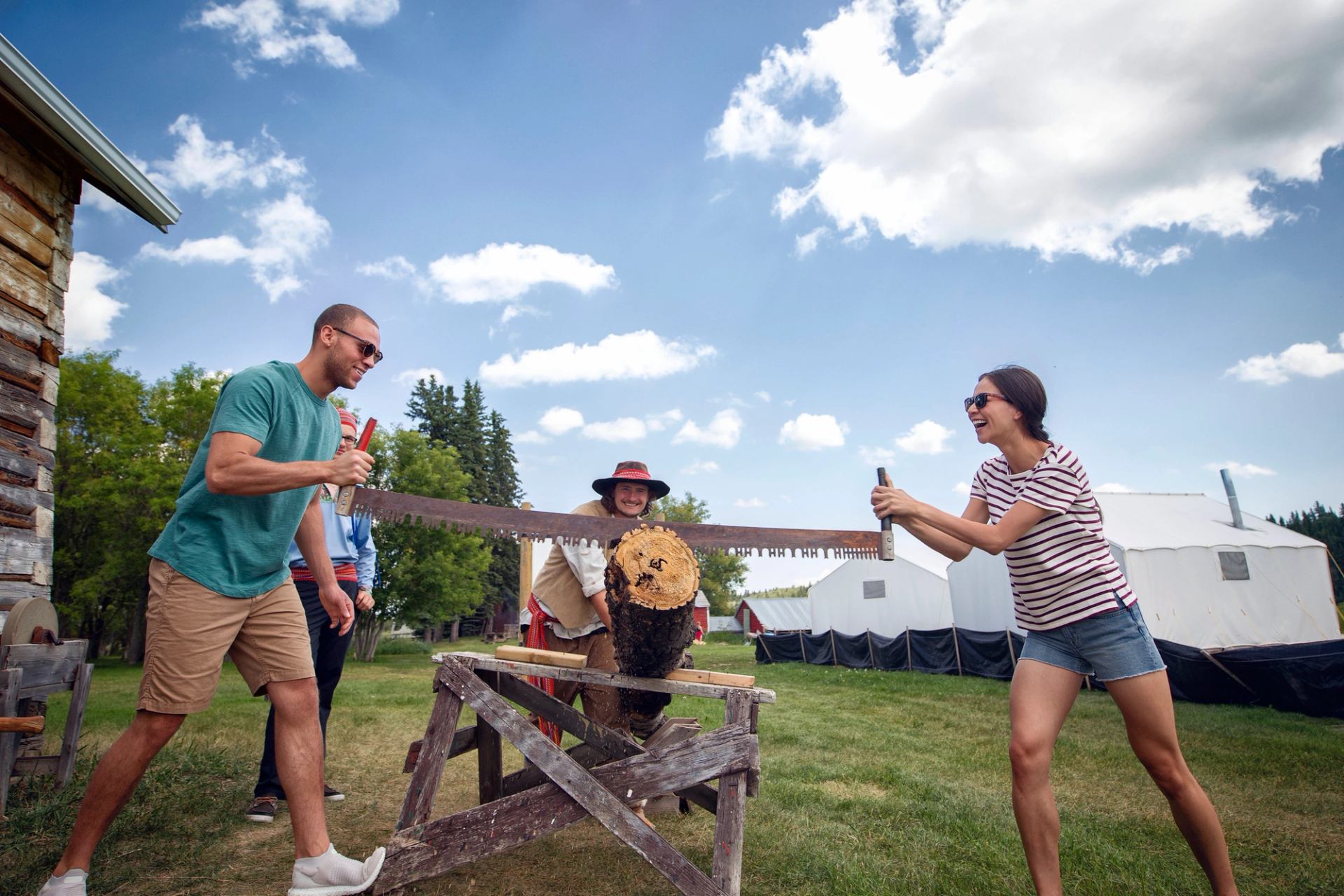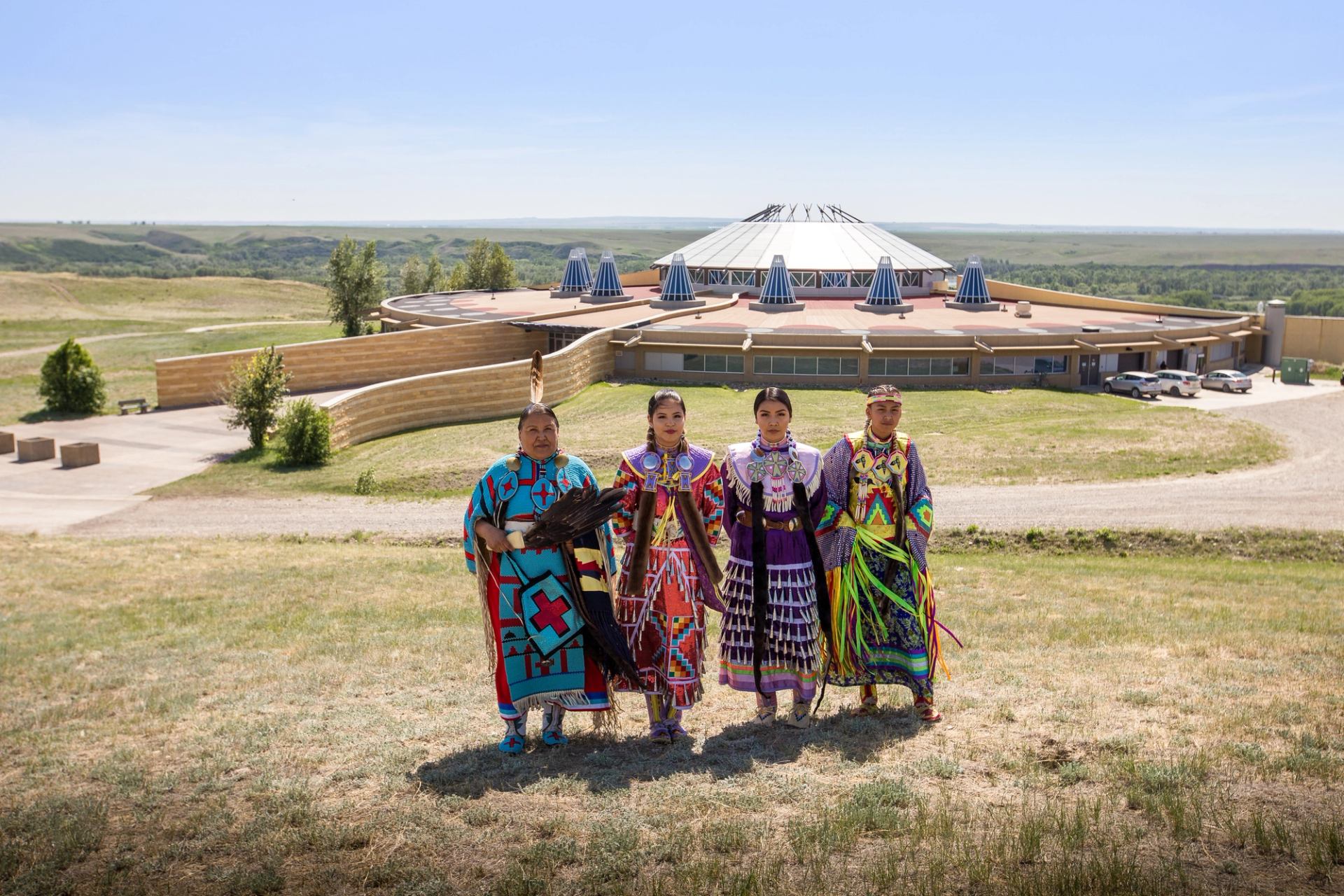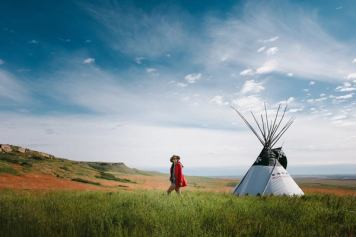Indigenous groups in Alberta each have their own unique histories. The concept of a gathering place, however, remains a common thread for First Nations, Métis and Inuit people. Gathering places were used for trade, to hold important ceremonies and celebrations, and were sites of cultural exchange. Two of Alberta’s most significant historical Indigenous gathering sites are now home to world-class cultural centres. Here, you’ll find Indigenous life being celebrated and shared in distinct and fun ways.
Exploring Two of Alberta’s Largest Indigenous Cultural Centres

Reading time: 4 minutes
These two historic gathering sites invite visitors to celebrate and experience Indigenous life with engaging, hands-on activities.
- Blackfoot Crossing is a designated National Historic Site and museum.
- Métis Crossing is a cultural destination with interactive activities.
- Extend your stay in a traditional tipi or Métis Trapper Tent.
Blackfoot Crossing Historical Park
According to Blackfoot tradition, the site known as Blackfoot Crossing was discovered by the buffalo. The waters of the Bow River are shallower here, and that makes it one of the safest places to cross the river. The Blackfoot discovered the site after following a migrating bison herd and consider the place a gift from the Creator. It became such an important gathering spot, it was where Treaty No. 7 was signed between five First Nations in the region and the Canadian government. Today, Blackfoot Crossing is a designated National Historic Site and the location of Blackfoot Crossing Historical Park. It’s an impressive facility built for the promotion and preservation of the Siksika Nation, one of the treaty’s signatory nations.
Visiting Blackfoot Crossing Historical Park is an opportunity to feel the power of this landscape while learning about the history and culture of the Siksika Nation. The best way to see the museum is on a guided tour with a local interpreter.
“Our territory was defined by the buffalo,” explains Grant Many Heads, a cultural interpreter at Blackfoot Crossing Historical Park. “We followed migrating bison herds and had a vast territory. Chief Mountain, Cypress Hills, the Yellowstone River of Montana — we know these places through our oral history.”
The eco-friendly museum tells the history of the Siksika people, while the gift shop sells locally made handicrafts. At the onsite restaurant, you can sample traditional foods, including a variety of bison-focused dishes. You can even book an overnight stay in a traditional Blackfoot tipi. What stays with you are the stories and the cultural experiences.
“I enjoy sharing a different way to look at life,” Many Heads says. “I love it when we have Blackfoot children come through the park. Many of our people know little about our history. They leave proud – knowing where they come from.”

Métis Crossing
On the banks of the North Saskatchewan River near Smoky Lake, Métis Crossing was a major meeting site for Europeans and Indigenous Peoples. This included the Métis, a group with mixed Indigenous and European (primarily French) ancestry. The crossing was used to access fishing grounds to the north and buffalo hunting grounds to the south. It was the site of a Methodist mission and Victoria Settlement, a Hudson’s Bay trading post. Many Métis emigrated to this region from other parts of Canada to farm or work in the fur trade.
Today, Métis Crossing is home to Alberta’s first Métis cultural destination – built on the original river lots of the first Métis settlers in the region.
Alberta has the largest Métis population of any province or territory in Canada. It’s also the only province with a Métis land base recognized under provincial legislation. There are eight Métis settlements in Alberta.
The Métis Nation developed its own language, culture, music, food and traditional ways of living. One of the best places to experience this unique Indigenous culture is at Métis Crossing.
“The thing that makes Métis Crossing special is its authenticity,” says Juanita Marois, Executive Director of Métis Crossing. “It was dreamed, designed, constructed and is operated by Métis people. It’s a place of pride and reconciliation where we welcome the world to experience our culture.”
Begin by exploring the onsite museum and bison paddock. Next, follow costumed interpreters through a traditional harvesting camp and farmyards complete with traditional homesteads, gardens and real farm animals. Be sure to watch a few craft and skills demonstrations and try one of the many hands-on activities yourself.

Depending on when you visit (the site is open year-round), you can paddle a voyageur canoe, learn to track animals or try archery. There are traditional foods to sample, plus opportunities to learn how to weave a Métis sash or make moccasins. Extend your stay at the onsite campground or overnight in a replica Métis Trapper Tent. There’s also a lodge with 40 guest rooms to rest your head at.
“Métis Crossing is a place of pride where we gather and share our culture openly and freely,” says Lily Rose, Knowledge Holder for Métis Crossing. “I particularly enjoy sharing stories, history and culture with young children who discover they are Métis. They want to learn who they are. That, to me, is so vitally important.”



